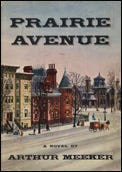In the 1880s and 1890s, Chicago's Prairie Avenue was the wealthiest street in the city, home to moguls like department store founder Marshall Field, railroad car manufacturer George Pullman and meat packer Philip Armour and their families. Arthur Meeker, the son of an Armour & Co. executive, grew up here and was intimately aware of its charms and scandals alike. By 1949 when he published Prairie Avenue, the soot and noise of the railroad had driven its upper class citizens northward, and the street was in decline. His novel is an affectionate recreation of a bygone era.
Almost the first half of the book is devoted to the year twelve-year-old Ned Ramsay, his parents having found themselves in financial embarrassment, spends with his relatives on Prairie Avenue. "The houses were of all sizes and shapes, and their styles were as varied as their building materials.... A balconied Venetian palazzo stood next a German gingerbread house with gargoyles on the roof, while a red brick Queen Anne mansion, a Byzantine fortress, and a Renaissance castle (all fancy grey stone embroidery) made an oddly assorted trio over the way.... Ned did not know what was wrong, but felt it without knowing and liked his uncle's tall yellow house, which was unpretentiously of no style at all, best of the lot."
Ned's Uncle Hiram is a wealthy businessman. His Aunt Lydia is beautiful, charming and mysterious, a continuing source of fascination to her nephew. The reader, if not Ned, quickly realizes she has a questionable background and is unfaithful to her husband, but her kindness to the lonely boy makes it impossible to condemn her. Ned's infatuation with Celia, the beautiful but distant daughter of Chicago's wealthiest man, brings the reader inside the Avenue's most sumptuous home and reveals that its inhabitants, too, have their secrets. But the novel is less about specific people than about the atmosphere of striving, conspicuous consumption, and secret heartache of a particular time and place. (1949, 308 pages)




